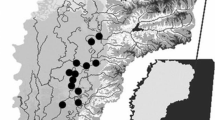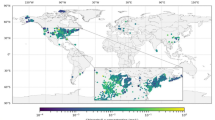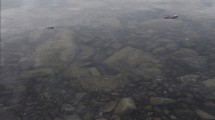Abstract
Remote sensing techniques may provide a higher temporal and spatial resolution than traditional water monitoring methods. We tested if this auxiliary information can be used to (i) explain patterns in fish assemblage composition and (ii) test candidate metrics to assess ecological status in large lake water bodies. We used MERIS-derived layers describing chlorophyll a, total suspended matter, and colored dissolved organic matter (CDOM) overlaid on all available fish monitoring data from the four largest Swedish lakes (Vänern, Vättern, Mälaren, and Hjälmaren). We assessed the influence of remote sensing-derived parameters in the pelagic, offshore benthic, and the inshore benthic habitats. Our results demonstrated that chlorophyll a and CDOM together with depth at the sampling site explained a significant part of the variation in the distribution of fish assemblages. These predictors were particularly important not only in pelagic, but also in inshore benthic areas. Furthermore, we identified three potential candidate metrics to assess pressure from eutrophication in large lakes: density of pelagic fishes, biomass of planktivorous species, and the proportion of cyprinids when roach was excluded. Remote sensing was considered a useful tool to support analyses of fish community composition and dynamics.





Similar content being viewed by others
References
Achleitner, D., H. Gassner & M. Luger, 2012. Comparison of three standardised fish sampling methods in 14 alpine lakes in Austria. Fisheries Management and Ecology 19: 352–361.
ACRI-ST, 2011. The AMORGOS MERIS CFI software user manual & interface control document. PO-ID-ACR-GS-0003 Issue 3 rev. 0A 15/02/2007. http://earth.esa.int/services/amorgos/download/Amorgos_ICD-SUM_3.0a.pdf
Aglen, A., 1983. Random errors of acoustic fish abundance estimates in relation to the survey grid density applied. FAO Fisheries Report, 293–298.
Appelberg, M., H.-M. Berger, T. Hesthagen, E. Kleiven, M. Kurkilahti, J. Raitaniemi & M. Rask, 1995. Development and intercalibration of methods in Nordic freshwater fish monitoring. Water, Air and Soil Pollution 85: 401–406.
Argillier, C., S. Caussé, M. Gevrey, S. Pédron, J. De Bortoli, S. Brucet, M. Emmrich, E. Jeppesen, T. Lauridsen, T. Mehner, M. Olin, M. Rask, P. Volta, I. J. Winfield, F. Kelly, T. Krause, A. Palm & K. Holmgren, 2013. Development of a fish-based index to assess the eutrophication status of European lakes. Hydrobiologia 174: 193–211.
Axenrot, T., M. Ogonowski, A. Sandström & T. Didrikas, 2009. Multi-frequency echo sounding can discriminate between fish and mysids to estimate mysid abundance and distribution in ecosystem monitoring. ICES Journal of Marine Science 66: 1106–1110.
Baker, E. A., K. E. Wehrly, P. W. Seelbach, L. Wang, M. J. Wiley & T. Simon, 2005. A multimetric assessment of stream condition in the northern lakes and forests ecoregion using spatially explicit statistical modeling and regional normalization. Transactions of the American Fisheries Society 134: 697–710.
Balk, H., 2014. Information and downloads on the software SONAR5 Pro on http://folk.uio.no/hbalk/sonar4_5/index.htm.
Blabolil, P., M. Logez, D. Ricard, M. Prchalová, M. Říha, A. Sagoius, J. Peterka, J. Kubecka & C. Argillier, 2016. An assessment of the ecological potential of Central and Western European reservoirs based on fish communities. Fisheries research 173: 80–87.
Bouvet, M. & F. Ramino, 2010. Equalization of MERIS L1b products from the 2nd reprocessing, Technical Report ESA TN TEC – EEP/2009.521/MB, ESA.
Brockmann, C., M. Paperin, O. Danne & A. Ruescas, 2013. Multi-Sensor Cloud Screening and Validation: IdePix and PixBox. In Proceedings of the 2013 European Space Agency Living Planet Symposium. http://livingplanet2013.org/abstracts/850821.htm.
Carpenter, S. R., J. F. Kitchell, J. R. Hodgson, P. A. Cochran, J. J. Elser & M. M. Elser, 1987. Regulation of primary productivity by food web structure. Ecology 68(6): 1863–1876.
Carrascal, L. M., I. Galván & O. Gordo, 2009. Partial least squares as an alternative to current regression methods used in ecology. Oikos 118: 681–690.
CEC, 2000. Directive 2000/60/EC of the European Parliament and of the Council: Establishing a Framework for Community Action in the Field of Water Policy. Official Journal of the European communities, Luxemburg.
Champ, W. S. T., F. L. Kelly & J. J. King, 2009. The Water Framework Directive: using fish as a management tool. Biology and Environment: Proceedings of the Royal Irish Academy 109B: 191–206.
De’ath, G., 2002. Multivariate regression trees: a new technique for modelling species-environment relationships. Ecology 83: 1105–1117.
Degerman, E., J. Hammar, P. Nyberg & G. Svärdsson, 2001. Human impact on the fish diversity in the four largest lakes of Sweden. Ambio 30: 522–528.
Delwart, S., R. Preusker, L. Bourg, R. Santer, D. Ramon & J. Fischer, 2005. MERIS in-flight spectral calibration. International Journal of Remote Sensing 28: 3–4.
Emmrich, M., S. Brucet, D. Ritterbusch & T. Mehner, 2011. Size spectra of lake fish assemblages: responses along gradients of general environmental factors and intensity of lake-use. Freshwater Biology 6: 2316–2333.
Emmrich, M., I. J. Winfield, J. Guillard, A. Rustadbakken, C. Verges, P. Volta, E. Jeppesen, T. L. Lauridsen, S. Brucet, K. Holmgren, C. Argillier & T. Mehner, 2012. Strong correspondence between gillnet catch per unit effort and hydroacoustically derived fish biomass in stratified lakes. Freshwater Biology 57: 2436–2448.
EN 15910, 2014. Water quality – guidance on the estimation of fish abundance with mobile hydroacoustic methods.
ESA, 2006. MERIS Product Handbook, Issue 2.1, 24th October 2006, http://envisat.esa.int.
ESA, 2012. http://www.esa.int/Our_Activities/Observing_the_Earth/Envisat/ESA_declares_end_of_mission_for_Envisat.
ESA, 2013. Sentinel-3 User Handbook, Issue 1.0, 2nd September 2013, https://sentinel.esa.int.
European commission, 2003. Common implementation strategy for the water framework directive (2000/60/EC). Guidance Document No 2. Identification of Water Bodies.
Fontaine, B., et al., 2007. The European Union´s 2010 target: putting rare species in focus. Biological conservation 139: 167–185.
Fox, J. & A. Nino-Murcia, 2005. Status of species conservation banking in the United States. Conservation Biology 19: 996–1007.
Freyhof, J. & E. Brooks, 2011. European Red List of Freshwater Fishes. Publications Office of the European Union, Luxembourg.
Gassner, H., G. Tischler & J. Wanzenböck, 2003. Ecological integrity assessment of lakes using fish communities – suggestions of new metrics developed in two Austrian prealpine lakes. International Review of Hydrobiology 88: 635–652.
Harvey, T., S. Kratzer & P. Philipson, 2015. Satellite-based water quality monitoring for improved spatial and temporal retrieval of chlorophyll-a in coastal waters. Remote Sensing of Environment 158: 417–430.
HELCOM, 2012. Indicator based assessment of coastal fish community status in the Baltic Sea 2005-2009. Baltic Sea Environment Proceedings Number 131.
HELCOM, 2015. Guidelines for Coastal Fish Monitoring Sampling Methods of HELCOM, 27 pp.
ICES, 2011. Report of the Working Group on Fisheries Acoustics Science and Tech-nology (WGFAST), 10–13 May 2011, Reykjavík, Iceland. ICES CM 2011/SSGESST:12, 37 pp.
Jonsson, T., M. Setzer, J. G. Pope & A. Sandström, 2013. Addressing catch mechanisms in gillnets improves modelling of selectivity and estimates of mortality rates: a case study using survey data on an endangered stock of Arctic charr. Canadian Journal of Fisheries and Aquatic Sciences 70: 1477–1487.
Love, R. H., 1971. Dorsal aspect target strength of an individual fish. Journal of Acoustics Society of America 49: 816–823.
Matthews, M. W., S. Bernard & L. Robertson, 2012. An algorithm for detecting trophic status (chlorophyll-a), cyanobacterial-dominance, surface scums and floating vegetation in inland and coastal waters. Remote Sensing of Environment 124: 637–652.
Olin, M., M. Rask, J. Ruuhijärvi & J. Tammi, 2013. Development and evaluation of the Finnish fish-based lake classification method. Hydrobiologia 713: 149–166.
Olin, M., K. Holmgren, M. Rask, M. Allen, L. Connor, A. Duguid, W. Duncan, A. Harrison, T. Hesthagen, F. Kelly, A. Kinnerbäck, R. Rosell & R. Saksgård, 2014. Water Framework Directive Technical Report: Northern Lake Fish fauna ecological assessment. EUR – Scientific and Technical Research series, Report EUR 26515 EN.
Persson, L., S. Diehl, L. Johansson, G. Andersson & S. F. Hamrin, 1991. Shifts in fish communities along the productivity gradient of temperate lakes – patterns and the importance of size-structured interactions. Journal of Fish Biology 38(2): 281–293.
Ragnarsson-Stabo, H., T. Vrede, T. Axenrot & A. Sandström, 2014. Can multi-frequency acoustics improve the monitoring of large zooplankton in large temperate lakes? Aquatic Ecosystem Health and Management 17: 374–381.
Sandström, A., H. Ragnarsson-Stabo, T. Axenrot & E. Bergstrand, 2014. Has climate variability driven the trends and dynamics in recruitment of pelagic fish species in Swedish Lakes Vänern and Vättern in recent decades? Aquatic Ecosystem Health and Management 17: 349–356.
Santer, R. & F. Zagolski, 2009. Improve contrast between ocean and land. ATBD-MERIS level-1c, Rev. 1. Rep.D6 (1), 6 January 2009, Univ. Littoral, France.
Schroeder, T., I. Behnert, M. Schaale, J. Fischer & R. Doerffer, 2007a. Atmospheric correction algorithm for MERIS above case-2 waters. International Journal of Remote Sensing 28(7): 1469–1486.
Schroeder, T., M. Schaale & J. Fischer, 2007b. Retrieval of atmospheric and oceanic properties from MERIS measurements: a new Case-2 water processor for BEAM. International Journal of Remote Sensing 28(24): 5627–5632.
SWAM, 2012. God havsmiljö för 2020. Havs- och vattenmyndighetens rapport, 2012:20. In Swedish:”Healthy marine environments in 2020.”
Swedish EPA, 2015. Mål i sikte. Analys och bedömning av de 16 miljökvalitetsmålen i fördjupad utvärdering. Report number 6662. In Swedish: “Target in sight. Analysis and evaluation of Sweden´s 16 environmental quality targets, an extensive analysis.”
Thuiller, W., L. Brotons, M. B. Araujo & S. Lavorel, 2004. Effects of restricting environmental range of data to project current and future species distributions. Ecography 27: 165–172.
Winemiller, K. O., 1996. Factors driving temporal and spatial variation in aquatic floodplain food webs. In Polis, G. A. & K. O. Winemiller (eds), Food Webs. Integration of Patterns and Dynamics. Kluwer Academic Publishers, Boston.
Vätternvårdsförbundet, 2015. Uppföljning av vattenvårdsplan samt revidering för 2020. Vätternvårdsförbundets rapportserie, report number 122. In Swedish:”Assessment of Water management plan and revision for the year 2020.“
Yule, D. L., J. V. Adams, D. M. Warner, T. R. Hrabik, P. M. Kocovsky, B. C. Weidel, L. G. Rudstam & P. J. Sullivan, 2013. Evaluating analytical approaches for estimating pelagic fish biomass using simulated fish communities. Canadian Journal of Fisheries and Aquatic Sciences 70: 1845–1857.
Zuur, A. F., E. N. Ieno & G. M. Smith, 2007. Analysing Ecological Data. Springer Science, New York.
Acknowledgments
This study was funded by the Swedish Space Board and the Water conservation societies of L. Vänern, L. Vättern, L. Mälaren, and L. Hjälmaren. It was partly funded by the Swedish Environmental Protection Agency (Dnr 10/179) and the Swedish Agency for Marine and Water Management through a contract for the research programme WATERS. We are indebted to the responsible persons at each water conservation society: Sara Peilot, Måns Lindell, Ingrid Hägermark, and Lotta Carlström. Our work was supported by a reference group consisting of Åsa Andersson, Susanne Kratzer, Niklas Strömbeck, and Per Wramner. We acknowledge the excellent working conditions on R/V Asterix and R/V Ancylus and all the personnel who have contributed to the monitoring programs on fish over the years. We are also thankful for additional support from Willem Dekker on validation and analyses of trawl data and for the valuable comments from two anonymous referees.
Author information
Authors and Affiliations
Corresponding author
Additional information
Guest editors: Paula Kankaala, Tiina Nõges, Martti Rask, Dietmar Straile & Arkady Yu. Terzhevik / European Large Lakes IV. Ecosystem Services and Management in a Changing World
Electronic supplementary material
Below is the link to the electronic supplementary material.
Rights and permissions
About this article
Cite this article
Sandström, A., Philipson, P., Asp, A. et al. Assessing the potential of remote sensing-derived water quality data to explain variations in fish assemblages and to support fish status assessments in large lakes. Hydrobiologia 780, 71–84 (2016). https://doi.org/10.1007/s10750-016-2784-9
Received:
Revised:
Accepted:
Published:
Issue Date:
DOI: https://doi.org/10.1007/s10750-016-2784-9




